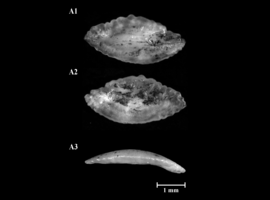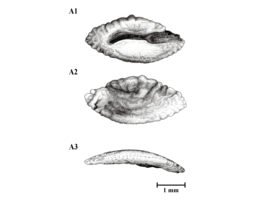Diplectrum formosum (Linnaeus, 1766)
(Serranidae, Perciformes)
Ocorre da Virginia (Estados Unidos) ao Uruguai. Atinge 30 cm de comprimento e é encontrada desde a costa até 80m de profundidade (Menezes & Figueiredo, 1980. Comedores de peixes e invertebrados bentônicos (camarões) (Soares et al., 2008).
The collection contains otoliths from 30 individuals of this species, ranging from 49 to 151 mm of total length. Click here to see the map of the sampling area for the individuals of this species. The following summaries contains data from 1 analysed otoliths. See more detailed data here (in portuguese).


Otoliths from Diplectrum formosum, with total length of A. 86mm; internal side A1; external side A2; profile of the ventral region A3; click the figures for larger version*
Morphology:
Shape: elliptic. Anterior region: peaked-round. Posterior region: peaked-round. Dorsal edge: lobed to sinuate. Ventral edge: sinuate to entire. Profile: concave-convex. Rostrum and antirostrum orientation: not applicable. Rostrum: Developed. Antirostrum: absent. Pseudorostrum: absent. Pseudoantirostrum: absent. Sulcus acusticus: position median, orientation horizontal, opening ostial, morphology heterosulcoid, colliculum heteromorphic, ostium funnel-like, cauda strongly curved tubular.
Description of the terms used
Morphometry:
| Shape indices | Mean ± sd | Minimum | Maximum |
|---|---|---|---|
| OL / TL % | 4.34 ± 0.00 | 4.34 | 4.34 |
| OH / OL % | 46.92 ± 0.00 | 46.92 | 46.92 |
| OT / OL % | 20.91 ± 0.00 | 20.91 | 20.91 |
| OT / OH % | 44.57 ± 0.00 | 44.57 | 44.57 |
| Circularity | 18.25 ± 0.00 | 18.25 | 18.25 |
| Rectangularity | 0.68 ± 0.00 | 0.68 | 0.68 |
* Vouchers:
Collection identifier for the individuals shown on photography and drawings:
- 25.3.DIFO.PI.AF.20.5 (86 mm)
For more information about this species:





